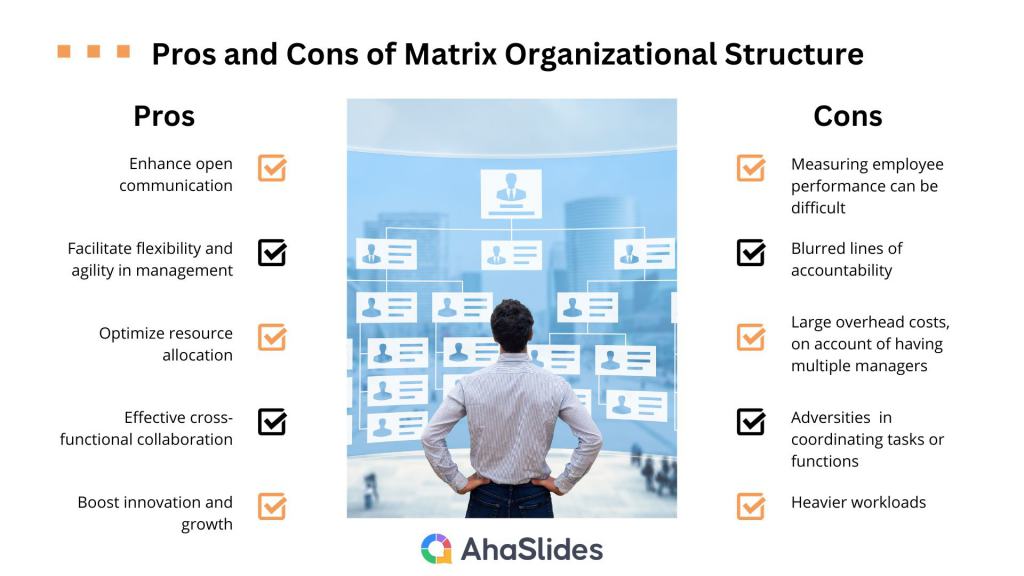The Matrix Organizational Structure - a powerful way for companies to organize themselves for success. So, what is the matrix structure best for?
In this article, you will learn more insight into what Matrix Organizational Structure is, why it matters, and how it reshapes the way businesses thrive in today's business world. So, let's dive in!
Table of Contents
- What is a Matrix Organizational Structure?
- What are the Characteristics of a Matrix Organizational Structure?
- Why is Matrix Organizational Structure Important?
- What is the Best Example of a Matrix Organizational Structure?
- Key Takeaways
- Frequently Asked Questions
| When did the matrix structure start? | The 1950s. |
| What are matrix organizational structure company examples? | Caterpillar, Texas Instruments, Phillips. |
What is a Matrix Organizational Structure?
A matrix organizational structure is an organization model employed by businesses and various other entities. It involves integrating two or more conventional organizational structures, usually the functional framework and the project or product-oriented framework.
In a matrix organizational structure, employees maintain multiple reporting lines, answering to more than one supervisor or manager. The primary goal of this structure is to enhance responsiveness to new project launches and foster open communication within the organization.

Looking for an interactive way to onboard your employees?
Get free templates and quizzes to play for your next meetings. Sign up for free and take what you want from AhaSlides!
🚀 Grab Free Account
What are the Characteristics of a Matrix Organizational Structure?
The following characteristics are essential in understanding how a matrix organizational structure operates and differentiates itself from other types of organizational structures.
- Dual Reporting: Employees report to both a functional manager and a project or product manager, creating dual reporting relationships.
- Integration of Structures: It combines elements of traditional organizational structures, such as the functional (departmental) structure and the project-based or product-based structure.
- Functional Departments: The organization maintains specialized functional departments (e.g., marketing, finance, HR) that focus on specific areas of expertise or resources.
- Project or Product Teams: Cross-functional project or product teams are formed to work on specific initiatives, projects, or products.
- Collaboration: Matrix structures encourage collaboration, with team members from different functional areas coming together to work on projects, leveraging their specialized skills.
- Complex Communication: Due to multiple reporting lines, communication within a matrix structure can be complex as employees need to balance the expectations of both their functional manager and project or product manager.
- Flexibility: Matrix structures offer flexibility to adapt quickly to changing circumstances, market demands, or project needs by reallocating resources and personnel.
- Resource Sharing: Resources, including human resources, are shared across projects and functions, leading to efficient resource allocation.
- Varied Authority Levels: Different variations of the matrix structure exist, such as weak matrix, strong matrix, and balanced matrix, which determine the degree of authority and influence of project or product managers compared to functional managers.
- Temporary or Permanent: Matrix structures can be temporary for specific projects or ongoing as a permanent part of the organizational design.

Why is Matrix Organizational Structure Important?
What are matrix organizational structure benefits? There is no doubt that matrix organizational structure is the key to business success in both the short term and the long term. Here are the reasons why companies should consider putting it into practice.
- Enhanced Communication: It is not hard to see how matrix structures improve communication by breaking down silos between departments. Highlight that open communication fosters collaboration and idea sharing.
- Flexibility and Agility: The adaptability of matrix structures to changing business environments helps organizations respond swiftly to market shifts and seize opportunities.
- Optimized Resource Allocation: Matrix structures maximize resource utilization and employee's skills are efficiently deployed across projects, boosting productivity.
- Cross-Functional Collaboration: In matrix organizational structure, the value of diverse teams within a cross-functional collaboration is extremely highlighted which can lead to innovative solutions and better decision-making.
- Innovation and Growth: Discussion and research on matrix structures will encourage innovation in work, as well as the development of new skills of employees when working on different projects, which will actively participate in the development of the organization.
What is The Best Example of Matrix Organizational Structure?
Take the global pharmaceutical Pfizer as an example of a matrix organizational structure. This is a practical sample of a successful matrix organizational structure that can be valuable for any company that wants to master this framework. Here's how Pfizer's matrix structure operates:

| Functional Departments | Pfizer has specialized functional departments, including Research and development (R&D), Manufacturing, Marketing, Sales, Finance, and Regulatory Affairs, among others. These departments focus on their specific areas of expertise. |
| Product-Based or Therapeutic Area Teams | Pfizer forms product-based or therapeutic area teams. For instance, Pfizer may have teams dedicated to developing and marketing drugs for cardiology, oncology, vaccines, or other therapeutic areas. |
| Dual Reporting | Employees at Pfizer often report to both a functional manager within their expertise area (e.g., a chemist reporting to an R&D manager) and a product-based or therapeutic area manager (e.g., a team working on a specific drug or vaccine). This dual reporting ensures that employees can contribute their functional expertise to the projects they're involved in. |
| Collaboration | The company relies on collaboration among employees from different functional backgrounds to develop, manufacture, market, and distribute pharmaceutical products. Cross-functional teams work together to bring drugs from the research phase to the market. |
| Complex Communication | Communication within Pfizer can be complex due to the multiple reporting lines and the need to coordinate efforts between functional departments and product teams. |
| Resource Sharing | Resources, such as research facilities, manufacturing capabilities, regulatory expertise, and marketing resources, are shared across functional departments and product teams to efficiently develop and bring new drugs to market. |
From this example, we can see how Pfizer's matrix structure allows the company to leverage the specialized knowledge and skills of its functional departments while also focusing on specific product portfolios or therapeutic areas.
Key Takeaways
In general, this structure is particularly well-suited to environments where research, development, flexibility, and regulatory compliance are critical and where products are often developed and marketed on a global scale.
🔥What's your next move? Head over to AhaSlides and learn the latest trends in business presentations, meetings, events, and team building. Reconnect with your employees in engaging real-time feedback.
Frequently Asked Questions
Where is matrix organizational structure used?
Matrix organizational structures are employed across industries like IT, construction, consulting, healthcare, manufacturing, academia, multinational corporations, creative agencies, and nonprofits. They facilitate resource allocation, cross-functional collaboration, and adaptability. However, organizations should consider their unique needs and potential challenges before adopting a matrix structure.
Why is Coca-Cola a matrix organizational structure?
Coca-Cola's matrix organizational structure plays a significant role in fostering cross-functional collaboration. Within this structure, functional experts from various departments seamlessly collaborate to achieve common goals. This collaborative approach is essential for product development, marketing campaigns, and distribution strategies. It ensures that diverse teams with specialized knowledge can work together efficiently, allowing Coca-Cola to remain agile and responsive in a fast-paced and competitive beverage market.
How do you manage a matrix organization?
Managing a matrix organization involves clear communication, role clarity, and teamwork. In a matrix organizational structure, strong leadership is vital for balancing functional and project demands, and conflict resolution mechanisms should be in place. Performance metrics align with both goals, resources prioritize strategic needs, and regular meetings keep teams informed. Technology tools streamline communication, training helps employees adapt, and feedback ensures ongoing improvement.
What are the disadvantages of a matrix organizational structure?
Not all businesses are suitable for using a matrix structure, especially in a more settled environment. It can be challenging when responsibilities and priorities are unclear, causing team members to feel torn between different project goals. Or, when there are blurry boundaries between roles and accountability, it can be tough to keep everyone on the same page and avoid conflicts between project and functional managers. Additionally, having too many managers can result in higher overhead costs.
Ref: nibussibessinfo | ChartHop | Simplilearn







